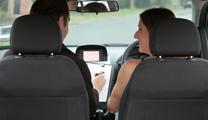The Signs You Need To Start Wearing Glasses When Driving
27 Jul 2024

Driving is an essential part of many people’s lives, offering freedom and convenience day to day. However, having clear vision while on the road is crucial for safety. Many drivers unknowingly put themselves and others at risk by not addressing changes in their eyesight.
In this blog post, we will be outlining the key signs that indicate that you may need glasses for driving. It’s important to pay attention to these signs and take the necessary steps to ensure you have clear vision when driving, for your own safety and others around you.
The key signs to look out for
Below are some of the main indicators that you need to visit your local optician to see if you need glasses for driving.
Blurred vision
One of the most clear signs that you might need glasses for driving is experiencing blurred vision. This can occur when trying to focus on distant objects, such as road signs or traffic lights. If you find yourself squinting frequently to make out words on road signs while driving, it might be time to schedule an eye exam with your eye care provider.
Blurred vision can result from several factors, including myopia (nearsightedness) or astigmatism. These conditions can worsen over time, leading to more significant challenges behind the wheel. These conditions can be effectively managed with corrective lenses, to ensure you can see clearly. It’s important to not ignore this common symptom.
Eye fatigue/strain
Another indication that you may need glasses for driving is if you are experiencing frequent eye strain or fatigue. Long hours on the road, particularly during night driving, can put a lot of extra stress on your eyes. If you start feeling tired or your eyes become sore after a long drive, this could suggest that your eyes are working harder than they should.
Eye strain can also turn into headaches, burning sensations, or a need to rub your eyes regularly. These symptoms suggest that your eyes are struggling to focus, and this could be because of uncorrected refractive errors. Visiting your optician is necessary to get the eye care you may need.
Difficulty driving at night
Driving at night presents a unique set of challenges, even for those with perfectly clear vision. However, if you find night driving particularly difficult, it could be an indicator that glasses are needed. Common difficulties include glare from oncoming headlights,reduced ability to see objects in low light, and seeing halos.
These symptoms might suggest a condition known as night blindness or a more general decline in vision quality. Astigmatism is also a common condition that causes difficulty driving at night.
For many drivers, wearing glasses specifically designed to address the difficulties you experience when it comes to night driving can drastically improve visibility and reduce glare. Making it easier and safer for you to drive at night. If you notice a marked difference in your comfort and safety levels between day and night driving, it’s time to explore corrective options.
If you need further support when it comes to night driving, contact our team today. You may benefit from a pass plus course that we offer here at Beverly Slater. A pass plus course involves receiving specialised help in certain areas of driving, for example, night driving.










